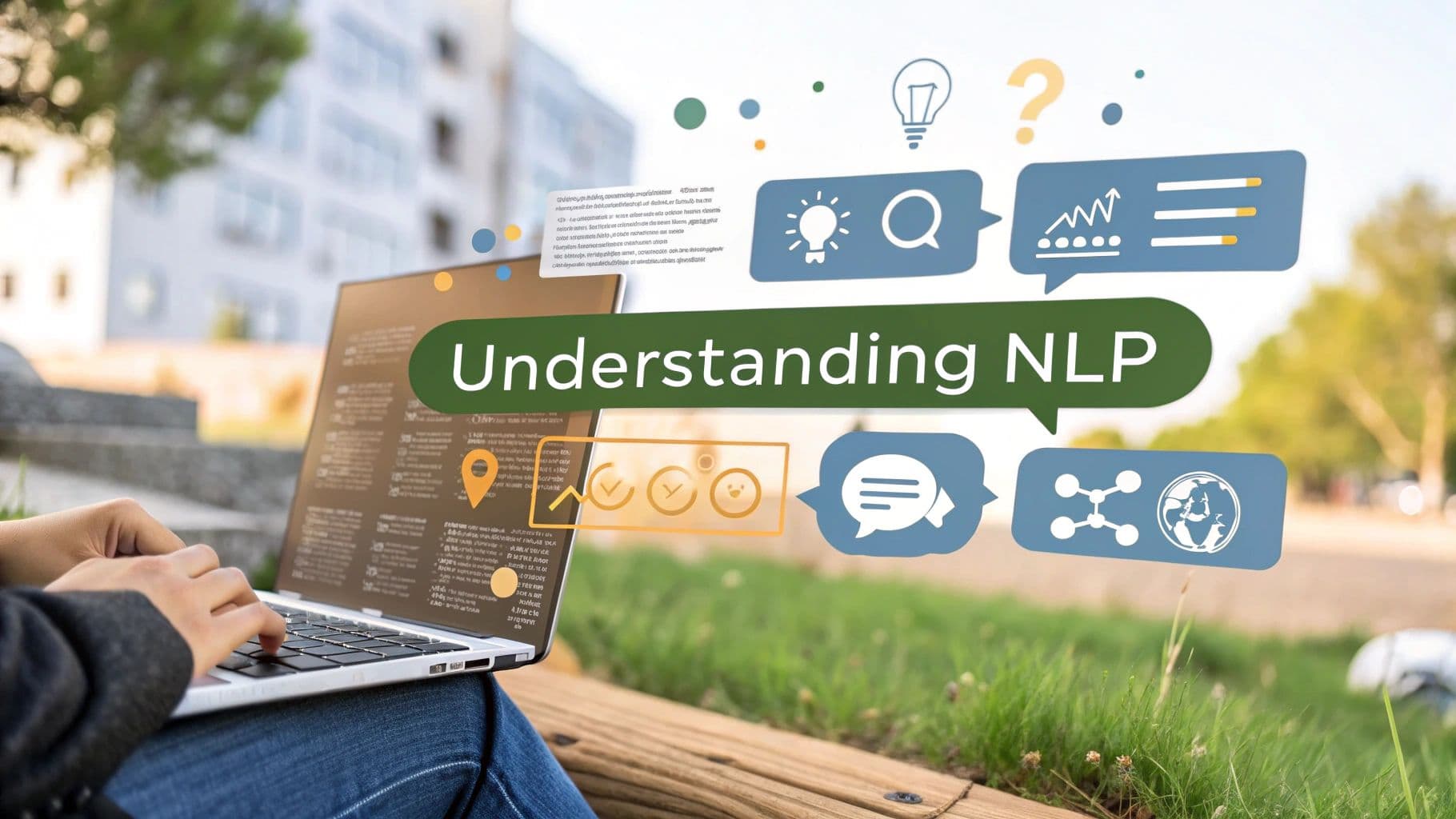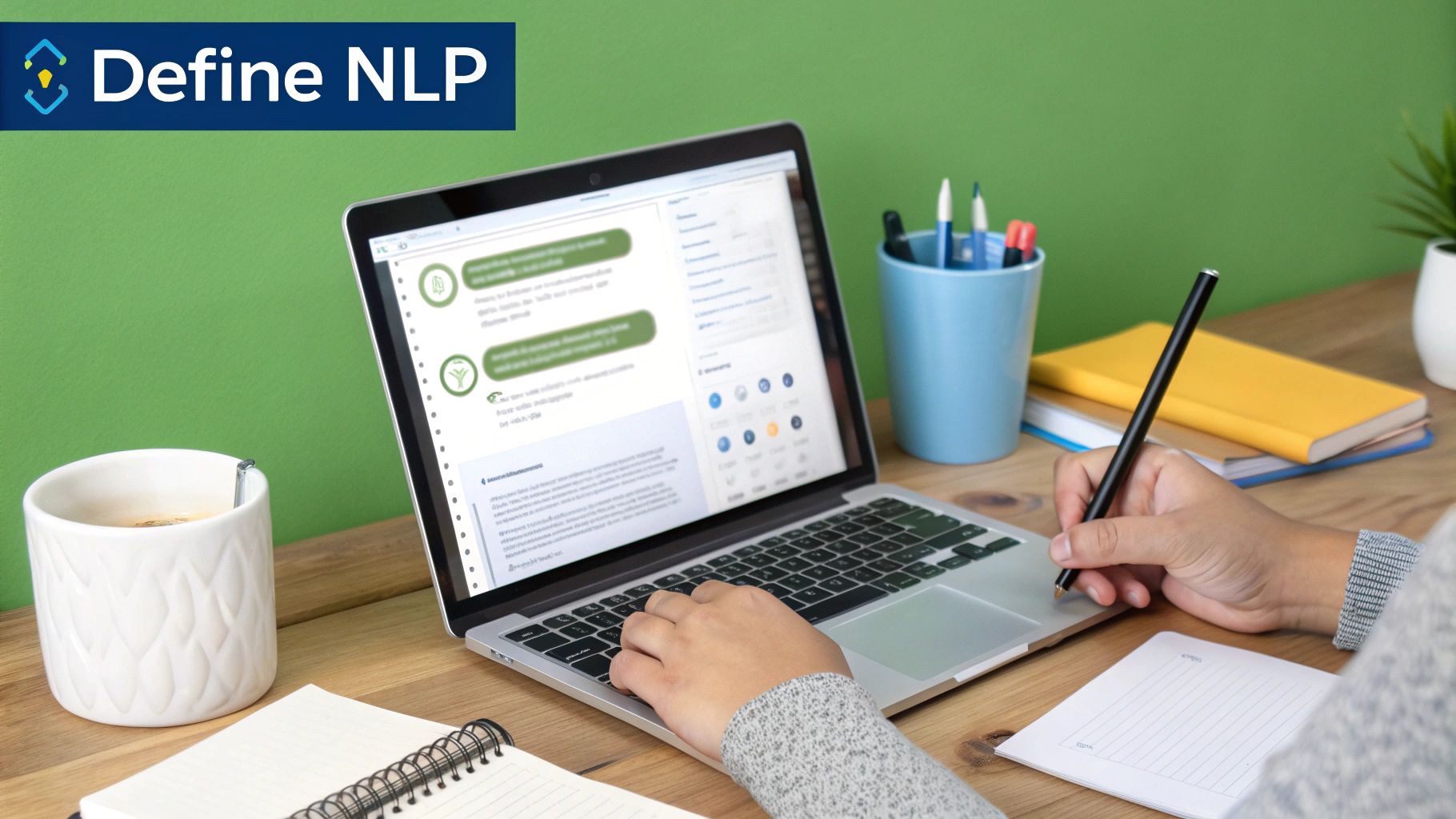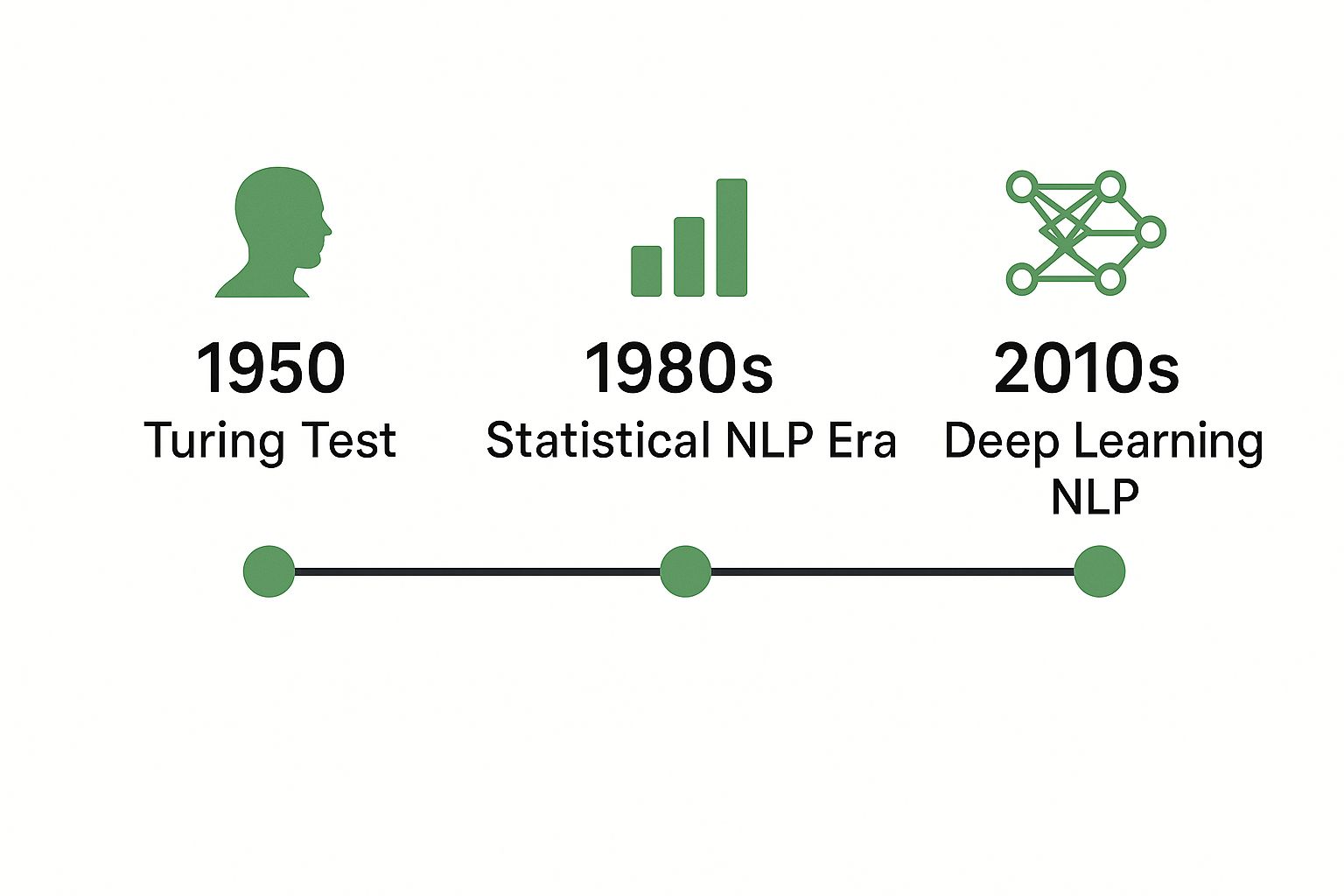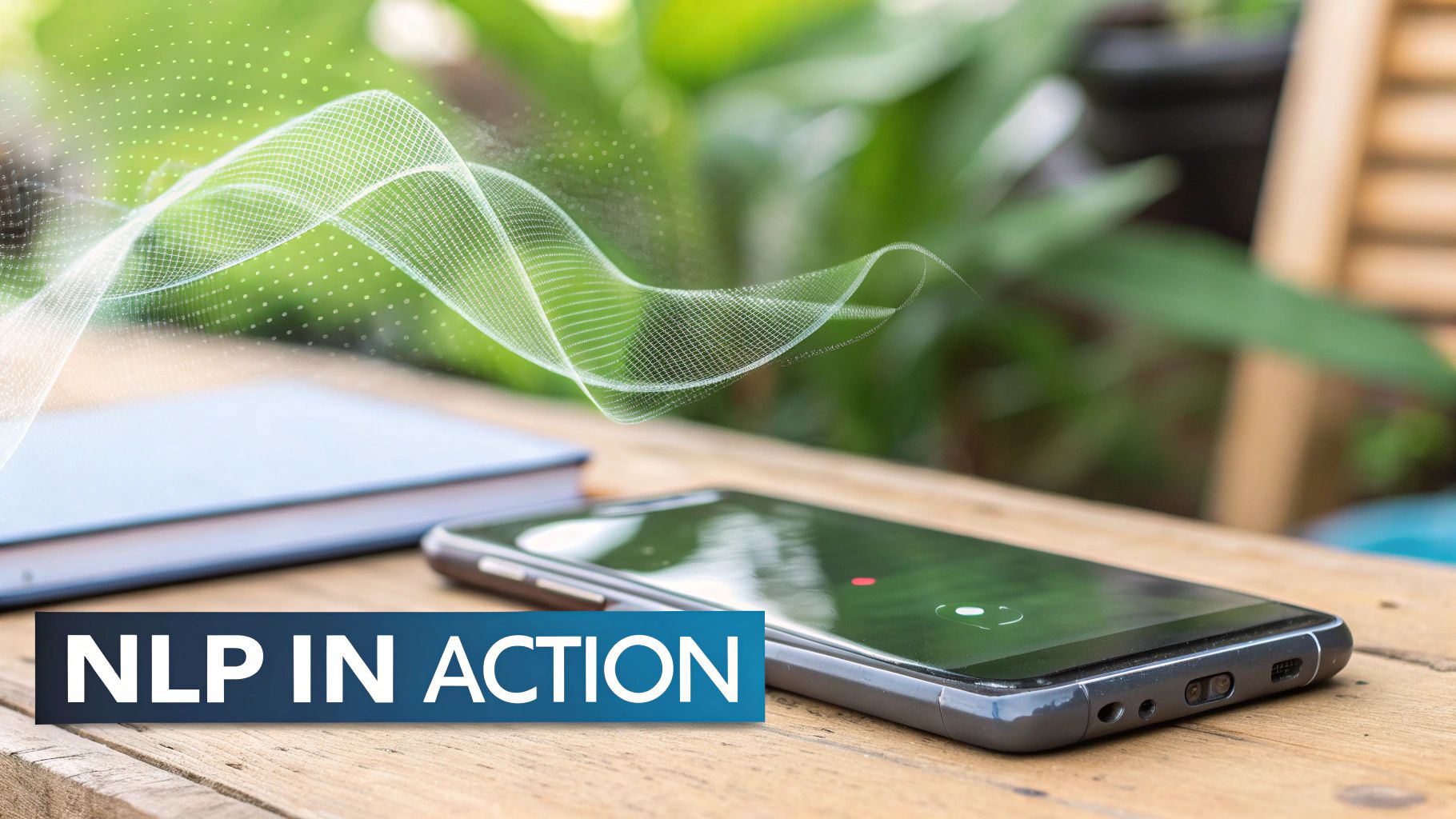
What Is Natural Language Processing Explained
October 6, 2025
Natural Language Processing, or NLP, is the magic behind the curtain of artificial intelligence, giving computers the ability to understand, interpret, and even generate human language. Think of it as a universal translator that closes the gap between how we talk and how machines process information. It’s the engine powering tools you probably use every single day.
Understanding Natural Language Processing

At its heart, what is natural language processing is really about appreciating just how messy human communication is. Our languages are brimming with sarcasm, metaphors, and inside jokes—all things that computers find incredibly difficult to wrap their digital minds around. NLP is the technology trying to solve that puzzle.
Instead of just spotting keywords, NLP algorithms dig deeper. They analyze the grammar of a sentence, figure out the relationships between words, and try to uncover the real intent behind them. This is what lets technology move past rigid, command-line instructions and toward the fluid, conversational experiences we have now.
The Goal of NLP
The main goal here is to make our interactions with computers feel more natural and less, well, robotic. It's all about teaching machines to read, decipher, and make sense of human language in a way that’s actually useful.
This breaks down into a few key areas:
- Automating communication: Think of chatbots answering customer questions or your inbox automatically sorting emails. That's NLP handling tasks without needing a person to step in.
- Extracting insights: It can analyze massive amounts of text—like thousands of customer reviews or social media posts—to spot trends and gauge public sentiment.
- Improving accessibility: This is what powers tools like voice-to-text on your phone and real-time language translation, making information available to everyone.
NLP is a cornerstone of modern AI because it unlocks the vast sea of unstructured data out there. A staggering 80% of all data is unstructured, meaning it doesn't fit neatly into a spreadsheet or database. NLP gives us the tools to process all that text and speech, turning it into something we can actually act on.
Natural language processing isn’t just about teaching machines to read; it's about teaching them to comprehend. The difference is what separates a simple search query from a meaningful conversation with a virtual assistant.
How It Works in Simple Terms
To help you get a quick grasp of the core ideas, here’s a simple breakdown.
| Natural Language Processing at a Glance |
| :--- | :--- | :--- |
| Concept | Description | Everyday Example |
| Speech-to-Text | Converting spoken words into written text. | Dictating a text message or talking to a smart speaker. |
| Intent Recognition | Identifying the user's goal behind their words. | Asking your phone, "What's the weather?" It knows you want a forecast. |
| Text Generation | Creating human-like text from scratch. | An AI writing assistant generating a draft for an email or blog post. |
This table shows just a few of the building blocks that make complex NLP applications possible.
Think about asking Siri or Alexa a question. You don't type a rigid command; you just speak. In that split second, your device is running a whole series of NLP tasks: it converts your speech to text, identifies key things like names or locations, understands your intent (are you asking for information or giving a command?), and then cooks up a relevant response.
That entire sequence is a perfect, real-world example of NLP in action. It’s the quiet engine that makes so many of our digital interactions feel intuitive, from Google Translate giving instant translations to your email client flagging a suspicious message as spam.
The Evolution of NLP From Rules to Learning
To really get what natural language processing is, you have to look at its journey. NLP wasn't an overnight success. It's the result of a decades-long mission to teach machines our most human skill: language. And it started with a simple, yet painfully difficult, idea.
The first attempts back in the 1950s were built on a foundation of rigid rules. Programmers would literally write out grammar guidelines, basically handing computers a dictionary and a grammar textbook. If a sentence didn't perfectly follow a pre-written rule, the whole system would just break. It was a brittle approach that couldn't handle the beautiful messiness of how people actually talk.
The Era of Rule-Based Systems
A classic example from this time was ELIZA, a program from 1966. ELIZA pretended to be a psychotherapist by cleverly twisting a user's sentences back into questions. It used simple pattern-matching to create an illusion of understanding, but it had no clue what anything actually meant. It was a neat trick, but it perfectly showcased the limits of a purely rule-based system.
For decades, NLP was stuck in this world of hand-crafted rules. They worked okay in super specific, controlled situations, but they could never scale. The sheer number of rules needed to cover every little exception and nuance in language was just impossible to write and maintain. Something had to change.
The history of NLP shows a clear shift from telling computers how to understand language with rules to showing them what language looks like through data. This change was the key that unlocked its modern potential.
The Shift to Statistical Learning
The big breakthrough finally came in the 1980s with the rise of statistical methods. Instead of feeding computers rules, researchers started feeding them massive amounts of text—books, articles, you name it. This giant collection of text, called a corpus, let machines learn patterns, probabilities, and word relationships all on their own.
This data-driven approach was a game-changer. The focus shifted from perfect, hand-written rules to probability. An NLP model could now figure out that the word "bank" was more likely to mean a financial institution when it saw words like "money" and "account" nearby. This was a huge leap toward understanding context.
This timeline gives you a great visual of the key milestones in the journey from stiff rules to flexible learning.

You can see how each era built on the last, pushed forward by more data and better computing power.
Deep Learning and Modern NLP
Today, we're in the era of deep learning—a powerful type of machine learning that uses complex structures called neural networks. These models, like the transformer architectures behind giants like BERT and GPT, can process language with a level of nuance that was once pure science fiction.
This whole progression, from the rule-based systems of the 1960s and 1970s to the statistical revolution of the 1980s and the deep learning models of today, tells a powerful story. If you want to dive deeper, you can explore a detailed timeline of these pivotal advancements in the history of natural language processing to see how each piece fit together.
The evolution isn't over, but the lesson is clear: to teach computers language, we had to stop giving them rigid instructions and instead let them learn from it directly. We had to move from rules to discovery.
How NLP Understands and Generates Language
Natural language processing is really a two-way street. On one side, it has to break down human language to figure out what we actually mean. On the other, it has to build new, human-like language from scratch. These two jobs are called Natural Language Understanding (NLU) and Natural Language Generation (NLG).
Think of it like a simple conversation. First, you have to listen and understand what the other person is saying—that’s NLU. Only then can you come up with a good response—that’s NLG. NLP models do the same thing, just at a mind-boggling scale and speed. Together, these two pillars let AI do more than just process words; they allow it to actually communicate.
The Detective Work of Natural Language Understanding
Natural Language Understanding, or NLU, is the input side of the process. Its main job is to act like a detective, sifting through the clues in raw text or speech to uncover the real meaning hiding underneath. It’s not just about knowing what words mean, but about grasping context, intent, and how different ideas connect.
When you ask your smart speaker, "Will I need an umbrella in Austin tomorrow?", NLU jumps into action. It doesn't just hear the words; it understands them. It figures out "Austin" is a place, "tomorrow" is a time, and "umbrella" is a clue that you're asking about rain. This is the core of what NLU does: it pulls structured, usable information out of our messy, unstructured language.
A few key tasks fall under the NLU umbrella:
- Named Entity Recognition (NER): This is all about identifying and categorizing key pieces of information, like names, organizations, places, dates, and even money. It’s how a system knows "Apple" is a company, not just a piece of fruit.
- Sentiment Analysis: This task figures out the emotional tone behind a piece of text—is it positive, negative, or just neutral? Businesses use this to make sense of thousands of customer reviews or social media comments almost instantly.
- Part-of-Speech Tagging: This is a more grammatical step where words are labeled as nouns, verbs, adjectives, and so on. It’s a basic but critical building block for understanding sentence structure.
NLU is the bridge from human ambiguity to machine certainty. It translates our messy, context-rich language into a structured format that a computer can actually work with and understand.
This ability to parse language is also what powers more complex systems. For example, understanding how an AI detector works involves realizing that these tools often use NLU to spot the statistical patterns and predictable structures common in machine-generated text.
The Storytelling of Natural Language Generation
Once a machine has understood the input (thanks to NLU), Natural Language Generation, or NLG, takes over to create the output. NLG is the storyteller. It takes structured data—like numbers in a spreadsheet or results from a database—and crafts a clear, human-readable story from it.
If NLU is about reading, NLG is all about writing. It’s the tech that turns a dry weather report showing a 70% chance of precipitation into a helpful sentence: "There's a high chance of rain in Austin tomorrow, so you should probably bring an umbrella." It makes complex data feel simple and easy to grasp.
You see NLG in action all the time, even if you don't notice it.
- Chatbot Responses: When a customer service bot gives you a genuinely helpful, conversational answer, that’s NLG at work.
- Automated Reporting: Financial companies use NLG to automatically write quarterly earnings reports, turning raw financial data into insightful summaries.
- Personalized Emails: Marketing platforms use NLG to create custom messages, dropping in your name and referencing past purchases to make the email feel like it was written just for you.
NLU and NLG are two distinct but complementary functions. This table breaks down the main differences.
NLU vs NLG A Simple Comparison
| Aspect | Natural Language Understanding (NLU) | Natural Language Generation (NLG) |
|---|---|---|
| Primary Goal | To interpret and comprehend human language. | To produce human-like text from data. |
| Process | Deconstructs language into structured data. | Constructs language from structured data. |
| Application | Analyzing customer feedback, powering voice commands. | Generating weather reports, writing chatbot replies. |
Ultimately, NLU and NLG are two sides of the same coin. NLU provides the understanding, and NLG provides the voice. Together, they create a complete conversational loop that lets machines interact with us on our own terms, using our own language. It’s this powerful combination that makes modern AI feel so sharp and interactive.
NLP Applications in Your Daily Life

You probably use natural language processing way more than you think. It's not some abstract concept locked away in a research lab; it’s woven into the very fabric of the digital tools you use every single day.
Most of the time, it works so smoothly you don’t even notice it. From checking your email first thing in the morning to asking a smart speaker for the weather, NLP is quietly working in the background to make your life just a little bit easier. By looking at these everyday examples, we can see how this tech bridges the gap between human language and digital efficiency.
The Virtual Assistant in Your Pocket
One of the most common places you'll find NLP is with virtual assistants. When you say, "Hey Siri, set a timer for 10 minutes," or "Alexa, what's on my calendar today?" you're kicking off a complex NLP process.
First, the device uses speech-to-text to turn your voice into written words. Then, it has to figure out your intent. The system gets that "set a timer" is a command and "10 minutes" is the key detail. This whole process of understanding your goal is what makes the interaction feel so seamless and conversational. If you want to go deeper into how AI analyzes speech and text, check out the field of conversation intelligence.
Your Email's Silent Guardian
Your inbox is another battlefield where NLP is constantly fighting for you. Spam filters are a perfect example. They don't just hunt for specific "bad" words; they analyze the entire email to figure out if it's legit or just junk.
These systems use classification models to spot the telltale signs of spam, like:
- Weird phrasing or grammatical mistakes that are common in phishing scams.
- A false sense of urgency or pushy language trying to get you to click a link.
- Mismatched sender info or sketchy links hiding in the text.
By weighing hundreds of factors like these, the NLP model gives the email a score and decides whether it belongs in your inbox or should be banished to the spam folder. This saves you from a daily avalanche of unwanted and potentially dangerous emails. It’s a great example of using NLP to create better experiences, and our guide on what is content personalization covers similar ideas for marketing.
The real power of NLP in daily life isn't just in flashy new features, but in its ability to handle tedious, high-volume tasks like filtering spam or translating text, freeing up our mental energy for more important things.
Breaking Down Language Barriers
Remember when online translators were a joke? They used to just swap words one-for-one, leading to clumsy and often hilarious results. Today's tools, powered by sophisticated NLP, are a world away from that. They understand grammar, context, and even slang to provide translations that are incredibly fluid and accurate.
This huge leap forward is thanks to the shift toward data-driven methods that started back in the 1980s. Systems like Google Translate were built on this idea, learning from billions of translated documents to figure out how phrases actually correspond between different languages.
It's no wonder the global NLP market was valued at USD 10.7 billion in 2019 and is still growing like crazy. The demand for tools that connect people across the globe is only getting stronger.
Humanizing Content in the Age of AI

As artificial intelligence writes more and more of what we read online, a new challenge has popped up: making that content feel genuinely human. AI-generated text often has a distinct, tell-tale quality. It might be grammatically perfect, but it lacks rhythm, falls back on repetitive sentence structures, or picks words that are correct but totally flat.
This robotic feel is more than just a style problem—it kills reader engagement. When content feels cold and impersonal, people can't connect with the message, and brands struggle to build trust. This is where a specialized kind of natural language processing comes in, one focused entirely on the art of humanization.
Why AI Text Needs a Human Touch
AI models learn language by chewing through massive datasets, spotting statistical patterns to guess the next best word in a sentence. It’s an incredibly powerful process, but it often leads to writing that’s predictable and misses the subtle quirks that make human writing so compelling.
This predictability shows up in a few common ways:
- Uniform Sentence Length: AI frequently churns out paragraphs where every sentence is roughly the same length, creating a monotonous, droning flow.
- Lack of Varied Punctuation: It often sticks to safe, simple periods and commas, shying away from things like em dashes or semicolons that add personality.
- Overly Formal Tone: Without clear direction, many models produce text that feels academic or stiff, completely missing a brand's unique voice.
These patterns aren't just noticeable to us; they're the exact signals that AI detection tools are designed to hunt for. For creators, this means their content could get flagged as AI-generated, which can hurt its credibility and maybe even its search engine performance.
Humanization is the process of injecting personality, rhythm, and authenticity back into AI-generated text. It's about transforming statistically probable sentences into engaging, persuasive, and genuinely readable content.
How NLP Humanizes AI Content
Advanced platforms like Natural Write use sophisticated NLP techniques to analyze and refine AI text, going way beyond a simple grammar check. The process involves a deep dive into the writing's structure, style, and flow to mirror the nuances of how people actually talk and write. It’s a multi-layered approach that gets to the heart of what makes writing sound robotic.
The technology hones in on several key areas for improvement:
- Sentence Structure Variation: NLP algorithms spot repetitive sentence patterns and start mixing things up. They might merge short, choppy sentences or break apart long, complex ones to create a more dynamic rhythm.
- Word Choice and Idiomatic Language: The system swaps out generic vocabulary for more vivid, context-aware words. It can also sprinkle in idiomatic expressions that make the text sound more natural and less like it came from a machine.
- Tone and Flow Adjustment: By analyzing the overall tone, the platform makes subtle tweaks to align the text with its goal, whether that's to be persuasive, informative, or just conversational. This keeps the voice consistent and authentic.
This is a critical step for anyone using AI to create content. By refining the output, you can ensure it not only bypasses AI detectors but, more importantly, forges a real connection with your audience. If you want to refine your own content, checking out an AI text humanizer can give you the practical tools to get these results.
Ultimately, this specialized use of what is natural language processing is becoming an essential strategy for marketers, writers, and students who want to maintain a genuine voice in an increasingly automated world.
A Few Common Questions About NLP
As you get more familiar with natural language processing, a few questions tend to pop up again and again. The whole field is tangled up with other big ideas like artificial intelligence and machine learning, so figuring out how they all fit together is a big part of the puzzle.
Let's clear the air on some of the most common points of confusion. Think of this as a quick Q&A to help you connect the dots and get a complete picture of NLP's place in the tech world.
AI vs. Machine Learning vs. NLP
This is probably the number one question people have: how do all these buzzwords relate? The simplest way to picture the relationship between Artificial Intelligence (AI), Machine Learning (ML), and Natural Language Processing (NLP) is to think of them as a set of Russian nesting dolls.
Artificial Intelligence (AI) is the biggest doll. It's the entire field dedicated to building machines that can think, reason, and learn like a person. It’s the broad umbrella covering everything from a robot playing chess to a self-driving car.
Inside that AI doll is the next one: Machine Learning (ML). ML isn't a separate thing; it’s a specific way of achieving AI. Instead of giving a computer explicit, step-by-step instructions for every single task, ML systems learn by finding patterns in massive amounts of data.
And finally, tucked inside ML, is the smallest doll: Natural Language Processing (NLP). NLP is a specialized part of AI that uses machine learning techniques to do one very specific thing: understand, interpret, and generate human language. So, NLP isn't competing with AI or ML—it’s a crucial piece of both.
In short: NLP is a type of AI that uses ML techniques to work with language. Each one is a component of the other, working together to create the smart tools we use every day.
Is NLP Hard to Learn?
That really depends on what you mean by "learn." If your goal is to understand the core ideas and see how NLP works in the real world—pretty much what we've covered here—then it's not hard at all. You don’t need a technical background to grasp the "what" and the "why."
But if you want to become an NLP developer and actually build these systems from the ground up, the learning curve gets steeper. That path requires a solid foundation in a few key areas:
- Programming: Most of the field runs on Python.
- Math: You'll need a good handle on statistics and linear algebra.
- Machine Learning: A deep understanding of how models learn from data is essential.
The good news? The barrier to entry is much lower than it used to be. Today, tons of pre-built NLP models and tools are available, letting developers add powerful language features to their apps without being a top-tier researcher.
How Does NLP Handle Different Languages?
This is one of the most exciting and important frontiers in NLP right now. For a long time, the field was heavily focused on English, but modern models are trained on gigantic, multilingual datasets. This allows them to handle tasks like translation and sentiment analysis across a huge range of languages.
A key technique behind this is called transfer learning. Picture a model that has become an expert in English after analyzing billions of documents. With transfer learning, you can take all that "knowledge" and adapt it to help the model learn a new language, even one with much less data available. It doesn't have to start from scratch.
Still, there are plenty of challenges left. Getting a model to understand regional dialects, slang, and subtle cultural nuances is still a tough nut to crack. The ultimate goal is to build systems that understand language the way it's actually spoken by everyone, everywhere.
What Are the Ethical Concerns with NLP?
Like any powerful technology, NLP comes with some serious ethical baggage. These conversations are critical to make sure these tools are used for good.
One of the biggest problems is bias. NLP models learn from text scraped from the internet, and in doing so, they can absorb and even amplify the human biases found in that data. If you’re not careful, this can lead to unfair or discriminatory results in things like job screening or loan applications.
Misuse is another huge concern. The same tech that can write a helpful email summary can also be used to generate convincing misinformation—or "fake news"—on a massive scale, blurring the line between fact and fiction.
And of course, there's privacy. This is a massive issue for tools like voice assistants or customer service chatbots that process personal, sensitive conversations.
Responsible NLP development is all about tackling these challenges head-on. It means actively working to reduce bias, building in safeguards against misuse, being transparent about how the tech works, and putting strong protections in place to secure user data.
Ready to elevate your AI-generated text and ensure it connects with your audience? Try Natural Write and transform robotic content into natural, engaging writing that bypasses AI detectors with a single click. Humanize your first draft for free.


